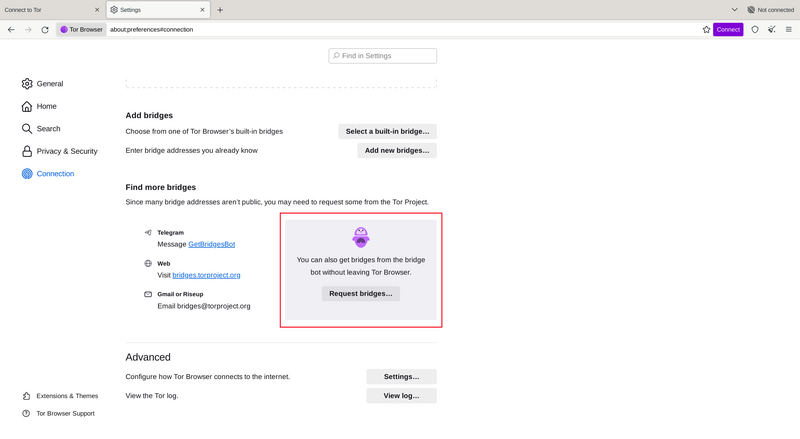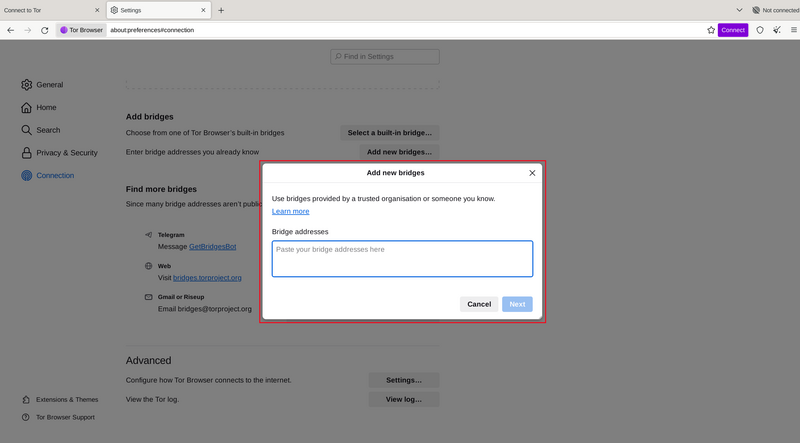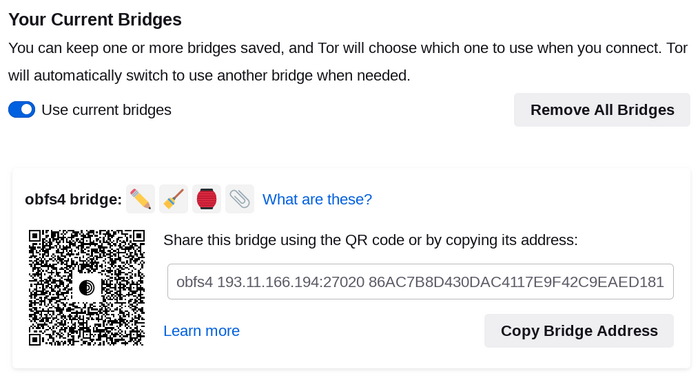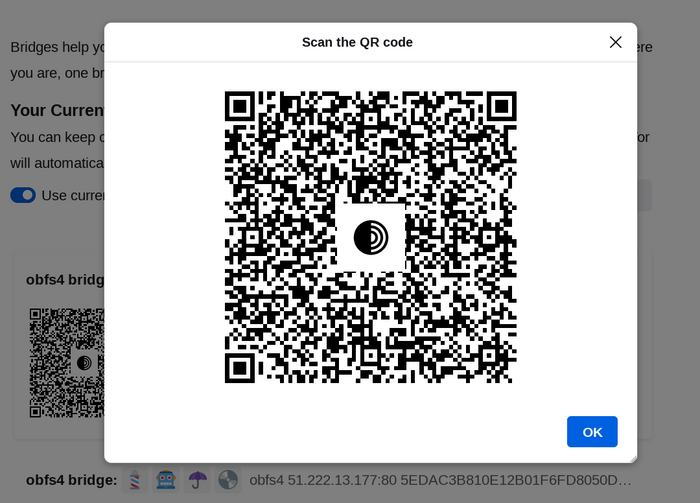Braitheann formhór Iompar In-Pluggable, mar obfs4, ar úsáid athsheachadáin “droichead”.
Cosúil le gnáth-athsheachadáin Tor, is oibrithe deonacha a reáchtálann droichid; murab ionann agus gnáth-athsheachadáin, áfach, níl siad liostaithe go poiblí, mar sin ní féidir le namhaid iad a aithint go héasca.
Trí dhroichid a úsáid i gcomhcheangal le hiompar plugáilte, cabhraíonn sé seo leat an fhíric go bhfuil tú ag baint úsáide as Tor a cheilt, ach d'fhéadfadh sé go gcuirfeadh sé moill ar an nasc i gcomparáid le gnáth-athsheachadáin Tor a úsáid.
Úsáideann iompróirí plocáilte eile, amhail meek agus gcáithnínísneachta, teicnící éagsúla frith-chinsireachta nach mbíonn ag brath ar sheoltaí droichead a aimsiú. Ní gá duit seoltaí droichid a fháil chun na hiompair seo a úsáid.
SEOLTAÍ DROICHID A FHÁIL
Toisc nach bhfuil seoltaí droichid ar fáil go poiblí, caithfidh tú iad a iarraidh as do stuaim féin. Tá cúpla rogha agat:
Iarr droichid ó laistigh de Bhrabhsálaí Tor
Má tá tú ag tosú Brabhsálaí Tor den chéad uair, cliceáil ar "Cumraigh Ceangal" chun an fhuinneog socruithe Tor a oscailt.
Sa rannán "Droichid", aimsigh an rogha chun "Tuilleadh droichid a fháil" agus cliceáil ar "Iarr droichid" le haghaidh Tionscadal Tor chun droichead a sholáthar.
Comhlánaigh an Captcha agus cliceáil "Cuir isteach".
Cliceáil “Ceangail” le do chuid socruithe a shábháil.
Nó, má tá Brabhsálaí Tor ar siúl agat, cliceáil ar "Socruithe" sa roghchlár hamburger (≡) agus ansin ar "Ceangail" sa bharra taoibh .
Sa rannán "Droichid", aimsigh an rogha chun "Tuilleadh droichid a fháil" agus cliceáil ar "Iarr droichid" le haghaidh Tionscadal Tor chun droichead a sholáthar.
Comhlánaigh an Captcha agus cliceáil "Cuir isteach".
Déanfar do shocrú a shábháil go huathoibríoch nuair a dhúnann tú an cluaisín.

Faigh droichid ó shuíomh Gréasáin Bridges
Tabhair cuairt ar ár láithreán gréasáin droichid.
Cliceáil ar 'Just a thabhairt dom droichid!' agus cóipeáil na línte droichead.
Nó bain úsáid as ardroghanna chun an cineál iompar plugála a roghnú agus ná faigh ach droichid le seoladh IPv6.
Faigh droichid trí Ríomhphost
Ríomhphost bridges@torproject.org ó sheoladh ríomhphoist Gmail nó Riseup agus cóipeáil na seoltaí droichid a fuarthas sa ríomhphost.
Faigh droichid trí Telegram
Seol teachtaireacht chuig @GetBridgesBot ar Telegram.
Tap on 'Start' or write /start in the chat.
To get bridges, type /obfs4 or /webtunnel.
Cóipeáil na seoltaí droichead.
SEOLTAÍ DROICHID A CHUR ISTEACH
Deisce Brabhsálaí Tor
Má tá tú ag tosú Brabhsálaí Tor den chéad uair, cliceáil ar "Cumraigh Ceangal" chun an fhuinneog socruithe Tor a oscailt.
Sa chuid "Droichid", ón rogha "Cuir isteach seoltaí droichead a bhfuil a fhios agat cheana féin" cliceáil ar "Cuir droichid nua leis" agus cuir isteach gach seoladh droichead ar líne ar leith.
Cliceáil “Ceangail” le do chuid socruithe a shábháil.
Nó, má tá Brabhsálaí Tor ar siúl agat, cliceáil ar "Socruithe" sa roghchlár hamburger (≡) agus ansin ar "Ceangail" sa bharra taoibh .
Sa chuid "Droichid", ón rogha "Cuir isteach seoltaí droichead a bhfuil a fhios agat cheana féin" cliceáil ar "Cuir droichid nua leis" agus cuir isteach gach seoladh droichead ar líne ar leith.
Déanfar do shocruithe a shábháil go huathoibríoch nuair a dhúnann tú an cluaisín.

Brabhsálaí Tor do Android
Tap ar ‘Settings’ (⚙️) agus ansin scrollaigh chuig an rannán ‘Ceangail’ de na socruithe.
Tap ar 'Config Bridge'.
Scoránaigh ar ‘Úsáid Droichead’ agus roghnaigh ‘Provide a Bridge I know’.
Cuir isteach seoladh an droichid.
Má theipeann ar an gceangal, b'fhéidir go bhfuil na droichid a fuair tú as fearas. Sa chás sin, ba chóir duit tuilleadh droichead a fháil trí cheann de na modhanna thuas, ansin iarracht eile a dhéanamh.
DROICHEAD-MOJI
Léirítear gach seoladh droichid ag teaghrán carachtair emoji ar a dtugtar Bridge-mojis. Is féidir an Bridge-mojis a úsáid chun a dheimhniú gur cuireadh leis an droichead atá beartaithe go rathúil.
Is aitheantóirí droichid inléite ag an duine iad Bridge-mojis agus ní ionann iad agus cáilíocht an naisc le gréasán Tor nó staid an droichid.
Ní féidir teaghrán na gcarachtar emoji a úsáid mar ionchur. Ní mór d'úsáideoirí seoladh iomlán an droichid a sholáthar le go mbeidh siad in ann nascadh le droichead.

Is féidir na seoltaí droichid a roinnt leis an gcód QR nó tríd an seoladh iomlán a chóipeáil.
